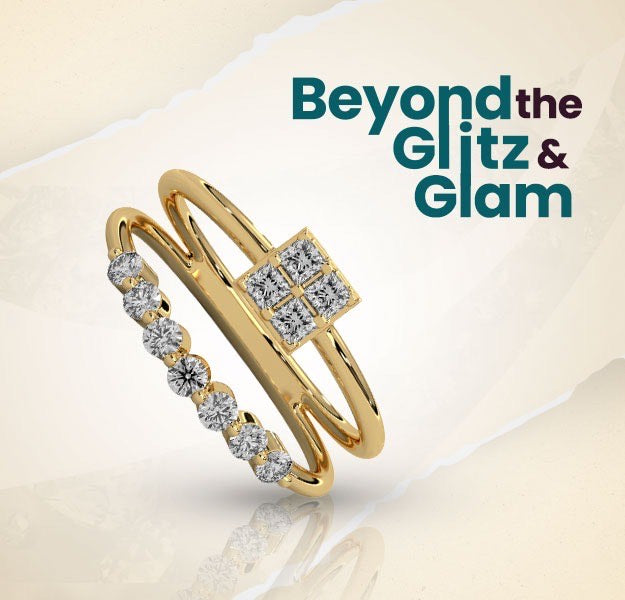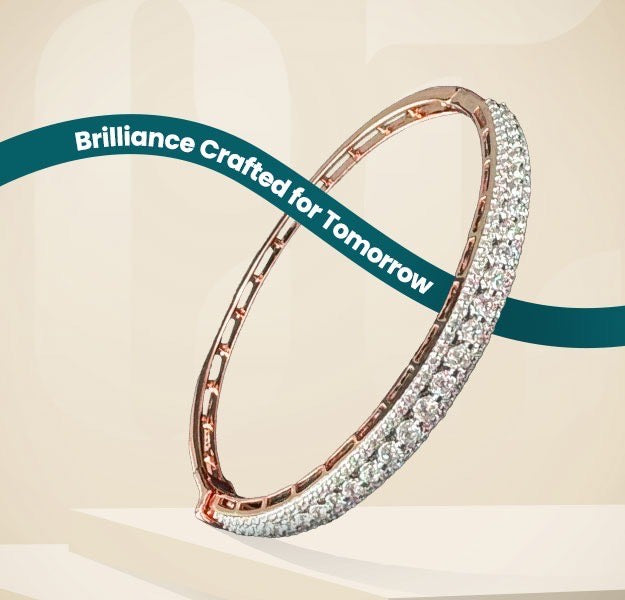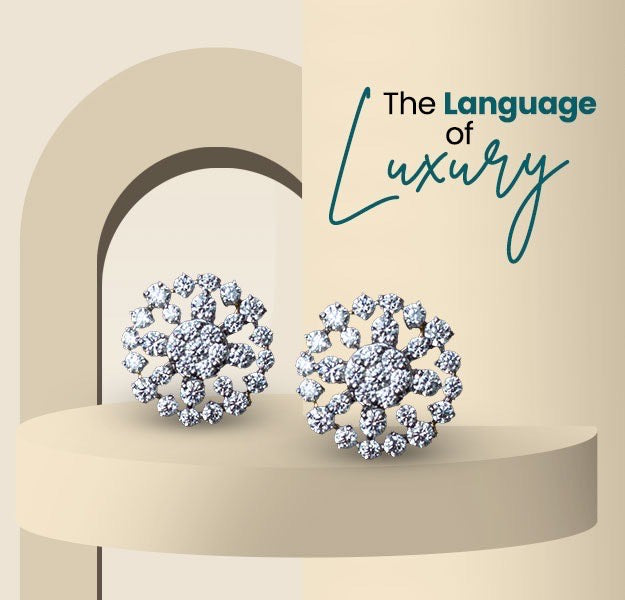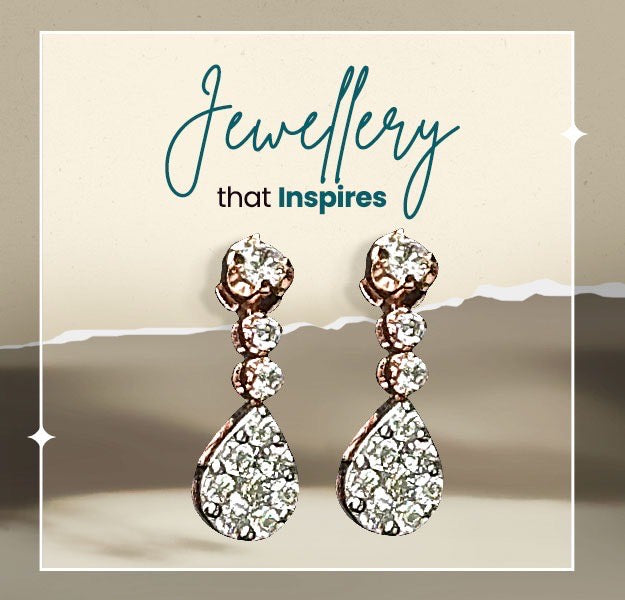Diamond Guide: The 4C's
Understanding the 4C's of Diamonds—Carat, Cut, Color, and Clarity—is essential to making a well-informed choice. Each factor plays a role in a diamond’s allure, value, and uniqueness. Our guide will help you explore these characteristics, making it easier to select the perfect diamond for your style and preferences.

1. Carat: Weight vs. Size
The carat weight of a diamond is often mistaken for its size. In reality, carat refers to weight, with one carat equaling 0.2 grams (roughly the weight of a paperclip). Carat weight can significantly affect a diamond’s price, but it’s important to remember that size isn’t everything; a well-cut diamond with lower carat weight can look just as stunning as a larger stone.
Craftier offers diamonds in a variety of carat weights to suit every style and budget. When multiple stones are included in a piece, such as in a pair of earrings, we use Total Carat Weight (TCW) to represent the combined weight of all stones in the design.
Carat vs. Karat: While carat measures the weight of diamonds and other gemstones, karat measures the purity of gold. It’s essential to know this difference when choosing pieces with mixed materials.

2. Cut: Bringing Diamonds to Life
A diamond’s cut is the most influential factor in its sparkle. More than just shape, cut refers to the angles, symmetry, and polish that affect how light interacts within the diamond. Expertly cut diamonds reflect and refract light with exceptional brilliance, fire, and scintillation—the qualities that give diamonds their iconic shimmer.
Popular Cuts:
- Round Cut: Known for maximum brilliance due to its 58 facets.
- Princess Cut: Square or rectangular with high sparkle.
- Oval Cut: Elegant, with a shape that elongates the appearance of rings.
- Cushion Cut: Square or rectangular with rounded edges, giving it a “pillow-like” look.
At Craftier, we ensure each diamond cut brings out the best in the stone, whether it’s a classic round or a unique cushion cut.

3. Color: The Art of Clarity and Light
Diamonds range from colorless to light shades of yellow or brown. Colorless diamonds (D-F) are rare and valuable, known for their pure sparkle and brightness. As color increases in intensity, the grade moves toward the lower end (G-Z), with diamonds exhibiting a slight tint.
At Craftier, we provide a range of color grades to suit diverse tastes. While colorless diamonds are prized, faintly colored diamonds offer a unique warmth and are ideal for specific settings. When purchasing diamonds, consider that certain settings, like yellow or rose gold, can make slightly tinted diamonds appear whiter, while white gold and platinum enhance colorless diamonds' purity.

4. Clarity: Nature’s Signature
Diamonds are formed under intense pressure over millions of years, so it’s natural for them to contain tiny imperfections known as inclusions (internal) and blemishes (external). Clarity measures how clean or “pure” a diamond appears; the fewer the inclusions, the higher the clarity grade.
Clarity Grading Scale:
- FL and IF: Flawless and Internally Flawless, rare diamonds with no visible inclusions at 10x magnification.
- VVS1 and VVS2: Very, Very Slightly Included, inclusions are barely visible under 10x magnification.
- VS1 and VS2: Very Slightly Included, minor inclusions.
- SI1 and SI2: Slightly Included, inclusions visible under magnification but typically invisible to the naked eye.
- I1, I2, I3: Included, with visible inclusions that can affect transparency.
At Craftier, we carefully select diamonds that balance clarity with beauty, providing options that suit every preference and budget.
Additional Tips for Buying Diamonds
-
Prioritize Cut for Maximum Sparkle
A diamond’s cut greatly impacts its brilliance; even a smaller diamond with an excellent cut can outshine a larger stone with a lower cut grade.
-
Consider “Near-Colorless” Diamonds
If you’re looking for value, diamonds in the G-J range offer a nearly colorless appearance at a more affordable price.
-
Match Carat with Setting Style
Higher carat weights are ideal for simple settings to showcase the diamond, while smaller diamonds can shine beautifully in cluster or halo settings.
-
Understand Total Carat Weight (TCW)
When buying multi-stone jewelry, the TCW indicates the combined carat weight. It’s crucial to differentiate TCW from individual carat weight to avoid misunderstandings.
At Craftier, we believe in offering diamonds that are as transparent as our values. Let us help you find the ideal lab-grown diamond to celebrate life’s most cherished moments.
Do Diamonds Come in Colors?
While many think of diamonds as purely colorless, they actually come in a wide range of stunning hues, from vibrant blues to subtle pinks, yellows, and even reds. These colored diamonds, also known as fancy-colored diamonds, are highly sought after for their rarity and unique beauty.
-
How Do Diamonds Get Their Color?
Color in diamonds is a result of trace elements and natural processes during their formation. For example:
- Nitrogen gives diamonds a yellow or orange hue.
- Boron results in rare blue diamonds.
- Radiation exposure can produce green diamonds.
-
Grading of Colored Diamonds
Colored diamonds are graded differently from colorless diamonds, focusing on three main factors:
- Base Color: Primary color of the diamond, such as blue, pink, or yellow.
- Intensity: The depth of color, ranging from faint to vivid.
- Secondary Colors: Many colored diamonds display a secondary hue, like a purplish-pink or greenish-blue.
The value of a colored diamond increases with the vibrancy and purity of its color. At Craftier, our collection includes select lab-grown diamonds in beautiful shades, offering a sustainable way to enjoy the elegance of colored stones.
How to Buy a Diamond Ring Without Getting Duped
Buying a diamond ring is an investment both financially and emotionally, so ensuring the authenticity and quality of your diamond is crucial. Here are key tips to help you make a secure purchase:
-
Understand the 4Cs
The cut, color, clarity, and carat weight of a diamond impact its quality and price. Familiarize yourself with these qualities so you can assess a diamond’s true value.
-
Insist on Certification
Reputable diamonds come with certification from trusted gemological institutes like the GIA or IGI. Certification provides an unbiased assessment of the diamond’s features, ensuring you receive the quality you’re paying for.
-
Choose a Reputable Seller
Always buy from a trusted jeweler with positive reviews and a clear reputation for quality. Be cautious with deals that seem too good to be true or lack transparency in sourcing and pricing.
-
Review Return and Refund Policies
Ensure the jeweler has a fair return and refund policy in place, especially for online purchases. This can be invaluable if you find discrepancies in quality after your purchase.
-
Know Common Diamond Substitutes
Cubic zirconia and moissanite are common diamond simulants. While these stones can be beautiful, they lack the durability, value, and brilliance of real diamonds.
At Craftier, we take pride in offering certified lab-grown diamonds, each accompanied by quality certification to guarantee your peace of mind.
How to Tell if a Diamond is Fake
When investing in a diamond, especially for the first time, it’s important to know if the stone you’re purchasing is genuine. Here are some straightforward ways to check if a diamond is real or fake:
-
The Fog Test
Hold the diamond close to your mouth and breathe onto it as you would a mirror. A genuine diamond will disperse the fog immediately due to its high heat conductivity, while a fake diamond may stay fogged for a few seconds.
-
The Water Test
Place the loose diamond in a glass of water. Due to their high density, real diamonds will sink to the bottom, while many fakes will float.
-
Use a Loupe
Inspect the diamond under 10x magnification with a jeweler’s loupe. Real diamonds often have tiny inclusions or flaws, while fakes typically look flawless or have bubbles.
-
Check the Setting
A genuine diamond is usually set in high-quality metal like platinum or gold, which will have visible markings. A lack of markings or inexpensive materials in the setting can be a red flag.
-
Refractivity Test
Diamonds bend light sharply, giving them a distinct sparkle. Place the diamond over text on a page. If you can read the text through the stone, it is likely a fake.
If you’re uncertain, visit a trusted jeweler for a professional inspection. Craftier’s lab-grown diamonds come with quality assurance, so you can shop with confidence.
Is Buying Diamond Jewelry a Good Investment?
Diamond jewelry, when selected thoughtfully, can be a rewarding investment. While they offer unique benefits, diamonds also require careful consideration. Here’s an overview of why diamond jewelry might be a good addition to your investment portfolio:
Portability and Storability
Diamonds are compact and easy to store, making them a convenient physical asset. They can be worn and enjoyed while retaining their value, unlike other investments that need to be stored securely out of sight.
Durability
Diamonds are among the hardest natural substances, meaning they won’t wear down over time. With basic care, diamond jewelry can maintain its brilliance and quality indefinitely.
Inflation Hedge
Like gold, diamonds are a physical asset and can offer protection against inflation. Their rarity and desirability contribute to their long-term value, making them a safe store of wealth.
Cons of Investing in Diamond Jewelry
Price Transparency
Unlike commodities like gold, diamond prices vary greatly based on individual characteristics and lack a standardized index. This can make it challenging to gauge fair market value.
Resale Challenges
Reselling diamonds can be difficult, and resale values can differ from purchase prices due to fluctuations in demand, grading, and other market factors.
Long-Term Investment
Diamonds are best suited for long-term holding as their value appreciation tends to be gradual. If immediate returns are a priority, other investments might be more suitable.
Tips for Making a Smart Diamond Investment
Buy Certified Stones
Certification from a reputable grading lab is essential to verify quality and protect your investment.
Choose Quality Over Size
Focus on the 4Cs to ensure you’re buying a high-quality diamond rather than prioritizing size alone.
Set a Budget
Diamonds can be a significant purchase, so it’s important to establish a budget and stick to it.
At Craftier, we offer certified lab-grown diamonds that align with both aesthetic and ethical values, making it possible to invest in high-quality jewelry with peace of mind.
